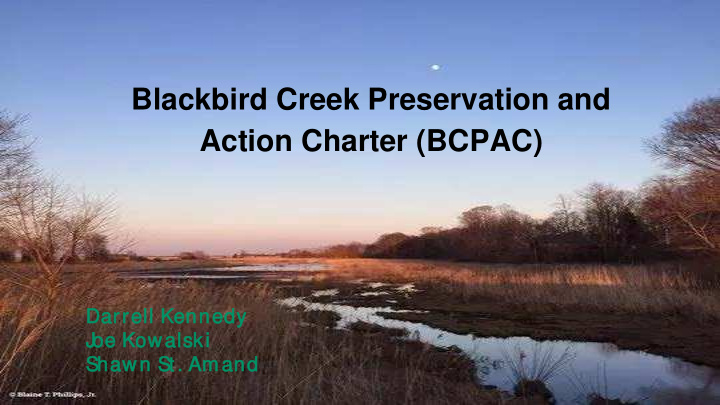



Blackbird Creek Preservation and Action Charter (BCPAC) Darrel ell Ken enned edy J oe oe Kow owalski Sha hawn n St . Amand nd
O utline • Watershed Overview • Current Status • Issues • Policies • Watershed Improvements • Water Quality • Ecological Preservation • Soil Erosion • Conclusion • Questions
M M i is s ion S S tatem m e ent BCPAC’s mission is to continue restoration of newly acquired land, increase the area of the natural reserve, reduce pollutant loads, and uphold current water quality standards of the Blackbird Creek Watershed in lower New Castle County, Delaware. This will be for immediate short-term efforts and provide an action plan for the years 2018 – 2023.
O utline • Wat er ershed ed O Over erview ew • Current Status • Issues • Policies • Watershed Improvements • Water Quality • Ecological Preservation • Soil Erosion • Conclusion • Questions
W ater ers hed ed O O ver erview ew • BCR vs BCW 0.6mi 2 vs 31mi 2 • • Some data from BCR • BCR representative of BCW • Majority of BCW drains through BCR
W ater ers hed ed O O ver erview ew • Few Roads • Small impervious areas • First/second order streams in west • Tidal marsh/wetlands in east
W ater ers hed ed O O ver erview ew • Population: 5465 • Land use: • 43% % Agr gricult ural • 35% Forest • 17% Wetlands • 4% Urban/residential • 1% Other
O utline • Watershed Overview • Cur urrent nt St at us us • Issues • Policies • Watershed Im provem ents • Water Quality • Ecological Preservation • Soil Erosion • Conclusion • Questions
Parameter Standard Existing Levels C urrent S t S ta tatu tus Dissolved Oxygen 5.5 mg/L average 5.1-6.4 mg/L* Phosphate 0.2 mg/L 0.51-0.60 mg/L Nitrate 3.0 mg/L 0.20-0.35 mg/L* ● 2012-2015 Study by Delaware Enterococcus 185 col/100mL 2000 col/100mL highest State University
C urrent I Issu ssues • Water quality • Pho hospha hat e - m ost likely from agriculture • Ba Bact eria - 17% Wetlands, 35% Forest • Eros osion on - from overland flow
C urren ent P P olic ies es • Delaware National Estuarine Research Reserve (DNERR) Management Plan - Rv.2013 • DNERR is a partnership between NOAA and DNREC • DNERR protects the Reserve and surrounding areas under the Coastal Zone Management Act • This Management Plan is for Blackbird Creek for the years 2013-2018. It has framework for: • Public access plan • Regulations on facility maintenance and public use areas • Resource protection including land acquisition policy
C urren ent P P olic ies es • Ecological Restoration Master Plan - March 2007 • Prepared by the Independent company, Biohabitat, Inc. • Created after DNERR recent purchase of 4 new tracts of land. • “Ensure environmental quality is preserved, to minimize detrimental impacts, and to mitigate invasive species”. • Provide long term research, educational insight, and promote BMPs for the Reserve's natural resources.
Total al M ax axim um D D ai aily Load ads • DNREC 2006 • Data from 1994-2003, mostly from 2002-2003 • HydroQual model • 40% reduction in NPS nitrogen and phosphorous, 80% reduction in NPS enterococcus WLA: Wasteload Allocation
O utline • Watershed Overview • Current Status • Issues • Policies • Wat er ershed ed I Improvem emen ent s • Water Quality • Ecological Preservation • Soil Erosion • Conclusion • Questions
W ater ers hed ed I Im provem em en ents
W ater ers hed ed I Im provem em ents - W en at ater Q ual ality • Phosphorus • Most likely from agriculture • Create or restore riparian buffer zones • Area around the stream and or creek • Plant native species • Soil testing to avoid overfertilization • Semi-annual: Consider before planting season and after harvesting season. • Nutrient timing strategies • Only apply fertilizer and pesticides when needed. (winter ban) • Bacteria • Concentrations are typical of a natural environment. • Acts as a natural biological barrier from pollutants for the surrounding environment.
W ater ers hed ed I Im provem em ents - E en co cologica cal P P res s e ervation • Assess current conditions, treat poorly conditioned areas, and monitor change in environment over time • Start with DNREC owned properties and expand out • Oversee and Monitor future change in ownerships of real estate property • Land Restrictions • Restricted to no development on agricultural lands 5-10 years from purchase date • No new industrial development without consent of DNREC and DNERR • Habitat restoration • Providing funding to the DNREC-Delaware Natural Heritage and Endangered Species Program Bald Eagle • Research habitat creating techniques and conduct habitat building projects
W ater ers hed ed I Im provem em en ents - S oi oil E E ros osion on • Problems: • Soil erosion as a result of heavy overland runoff from agricultural fields • Over foraging of geese • Sea level rise reducing marsh lands • Creates high TSS in water • Solutions: • Implement better stormwater management techniques • Water bars to dissipate kinetic energy of overland flow before entering stream • Plant species that slow shallow concentrated and open channel flow • Plant vegetation that geese won't eat & promote geese hunting • Make wetlands preservation a high area of focus • Sea level rise is inevitable
C on onc lus usion on • Watershed Overview • Current Status • Water Quality • Policies • Watershed Improvements • Water Quality • Ecological Preservation • Soil Erosion • Con onclusion on • Questions
Q ue ues tion ons
Recommend
More recommend